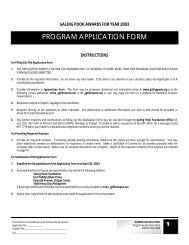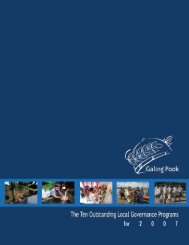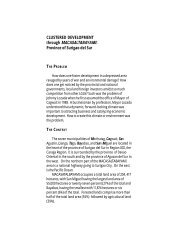kaban galing - front cover - galing pook
kaban galing - front cover - galing pook
kaban galing - front cover - galing pook
You also want an ePaper? Increase the reach of your titles
YUMPU automatically turns print PDFs into web optimized ePapers that Google loves.
The Creative Solution<br />
Knowing the importance of mangroves in fish breeding grounds, the<br />
people of Calag-itan began with the earnest rehabilitation of an initial<br />
half hectare. The site, which used to be a mangrove area had become<br />
barren over the years—evidence of the continuing deterioration of the<br />
marine ecosystem.<br />
After the establishment of the sanctuary, and despite massive<br />
education effort, poaching continued. This led the project managers to<br />
introduce seaweed production as a parallel support project to provide<br />
an alternative source of income for the fishing community while at the<br />
same time discouraging would-be poachers because of the enhanced<br />
visibility of the stakeholders in the sanctuary area. The local stakeholders<br />
organized themselves into the Calag-itan Guso Producers Association<br />
(CAGUPA). A Tacloban-based trader is now buying the seaweeds in<br />
bulk. They have also ventured into value-added seaweed products like<br />
pickles and seaweed-based maja.<br />
Assessment of the area was done in coordination with the Provincial<br />
Coastal Resource Management Office (PCRMO), gtz/Leyte Island<br />
Program and the Leyte State University. This was followed by a public<br />
presentation and forum to generate public awareness and understanding<br />
of the need for the project. Community education on the mutual<br />
dependence of flora and fauna and the value of environmental<br />
preservation gave the residents a better appreciation of the need to<br />
protect the environment.<br />
The multi-sectoral partnership mustered behind the project included<br />
the provincial government through the PCRMO, the gtz/Leyte Island<br />
Program, the regional office of the Bureau of Fisheries and Aquatic<br />
Resources, and the municipal government through the Municipal<br />
Agriculture Office. The project also established a partnership with the<br />
local academe through the Leyte State University Hinunangan Campus<br />
for technical assistance.<br />
The Alternative Becomes Mainstream<br />
Within a few years, the turn-around was well underway. This was<br />
confirmed by an underwater assessment of the project by the Resource<br />
Ecological Assessment Team of the Leyte State University in cooperation<br />
with gtz/Leyte Island Program of Southern Leyte in 2004. The team found<br />
very encouraging results.<br />
Profit Motive Saves Marine Sanctuary 33












![[Year] Paano Tayo Aasenso? - Galing Pook Foundation](https://img.yumpu.com/3809385/1/184x260/year-paano-tayo-aasenso-galing-pook-foundation.jpg?quality=85)